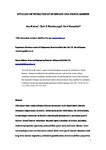Detailed investigation of overwash on a gravel barrier
| dc.contributor.author | Matias, M | |
| dc.contributor.author | Blenkinsopp, CE | |
| dc.contributor.author | Masselink, Gerd | |
| dc.date.accessioned | 2014-09-24T08:38:05Z | |
| dc.date.available | 2014-09-24T08:38:05Z | |
| dc.date.issued | 2014-04-01 | |
| dc.identifier.issn | 0025-3227 | |
| dc.identifier.issn | 1872-6151 | |
| dc.identifier.uri | http://hdl.handle.net/10026.1/3123 | |
| dc.description | The work was funded by the NUPSIG project (New Understanding and Prediction of Storm Impacts on Gravel Beaches) funded by the EPSRC (reference EP/H040056/1). The full text is under embargo until 01.10.15 | |
| dc.description.abstract |
This paper uses results obtained from a prototype-scale experiment (Barrier Dynamics Experiment; BARDEX) undertaken in the Delta flume, the Netherlands, to investigate overwash hydraulics and morphodynamics of a prototype gravel barrier. Gravel barrier behaviour depends upon a number of factors, including sediment properties (porosity, permeability, grain-size) and wave climate. Since overwash processes are known to control short-term gravel barrier dynamics and long-term barrier migration, a detailed quantification of overwash flow properties and induced bed-changes is crucial. Overwash hydrodynamics of the prototype gravel barrier focused on the flow velocity, depth and discharge over the barrier crest, and the overwash flow progression across and the infiltration through the barrier. During the BARDEX experiment, overwash peak depth (0.77m), velocity (5ms-1) and discharge (max. 6m3m-1) were high, especially considering the relatively modest wave energy (significant wave height=0.8m). Conversely to schemes found in the literature, average flow depth did not linearly decrease across the barrier; rather, it was characterised by a sudden decrease at the crest, a milder decrease at the barrier top and then propagation as a shallow water lens over the backbarrier. The barrier morphological evolution was analysed over a series of 15-min experimental runs and at the timescale of individual overwash events. Overall, the morphological variation did not result from an accumulation of many small consistently erosive or accretionary events, but rather the mean bed elevation change per event was quite large (10mm) and the overall morphology change occurred due to a small imbalance in the number of erosive and accretionary events at each location. Two relationships between overwash hydrodynamic variables were deduced from results: (1) between overwash flow depth and velocity a power-type relation was obtained; and (2) a linear relation was observed between overwash flow depth and maximum overwash intrusion distance across the barrier top (i.e. overwash intrusion). Findings from this study are useful to enhance the knowledge of overwash processes and also have practical applications. On the one hand, results shown here can be use for the validation of overwash predictive models, and additionally, the simple empirical relations deduced from the dataset can be used by coastal managers to estimate overwash intrusion distance, which in turn can assist in the location of areas under risk of overwash and breaching. © 2014 Elsevier B.V. | |
| dc.format.extent | 27-38 | |
| dc.language | en | |
| dc.language.iso | en | |
| dc.publisher | Elsevier BV | |
| dc.subject | BARDEX | |
| dc.subject | storm | |
| dc.subject | bed-level sensors | |
| dc.subject | gravel | |
| dc.subject | barrier | |
| dc.subject | coastal hazards | |
| dc.title | Detailed investigation of overwash on a gravel barrier | |
| dc.type | journal-article | |
| dc.type | Article | |
| plymouth.author-url | https://www.webofscience.com/api/gateway?GWVersion=2&SrcApp=PARTNER_APP&SrcAuth=LinksAMR&KeyUT=WOS:000335098100003&DestLinkType=FullRecord&DestApp=ALL_WOS&UsrCustomerID=11bb513d99f797142bcfeffcc58ea008 | |
| plymouth.volume | 350 | |
| plymouth.publication-status | Published | |
| plymouth.journal | MARINE GEOLOGY | |
| dc.identifier.doi | 10.1016/j.margeo.2014.01.009 | |
| plymouth.organisational-group | /Plymouth | |
| plymouth.organisational-group | /Plymouth/Faculty of Science and Engineering | |
| plymouth.organisational-group | /Plymouth/Faculty of Science and Engineering/School of Biological and Marine Sciences | |
| plymouth.organisational-group | /Plymouth/REF 2021 Researchers by UoA | |
| plymouth.organisational-group | /Plymouth/REF 2021 Researchers by UoA/UoA07 Earth Systems and Environmental Sciences | |
| plymouth.organisational-group | /Plymouth/Research Groups | |
| plymouth.organisational-group | /Plymouth/Research Groups/Marine Institute | |
| plymouth.organisational-group | /Plymouth/Users by role | |
| plymouth.organisational-group | /Plymouth/Users by role/Academics | |
| plymouth.organisational-group | /Plymouth/Users by role/Researchers in ResearchFish submission | |
| dc.identifier.eissn | 1872-6151 | |
| dc.rights.embargoperiod | Not known | |
| rioxxterms.funder | Engineering and Physical Sciences Research Council | |
| rioxxterms.identifier.project | New Understanding and Predicting Storm Impacts on Gravel beaches | |
| rioxxterms.versionofrecord | 10.1016/j.margeo.2014.01.009 | |
| rioxxterms.licenseref.uri | http://www.rioxx.net/licenses/all-rights-reserved | |
| rioxxterms.type | Journal Article/Review | |
| plymouth.funder | New Understanding and Predicting Storm Impacts on Gravel beaches::Engineering and Physical Sciences Research Council |


